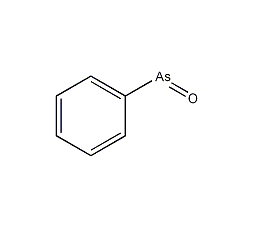
Structural formula
| Business number | 070F |
|---|---|
| Molecular formula | C6H5AsO |
| Molecular weight | 168.02 |
| label |
phenylarsenic oxide, benzene arsenic oxide, Arzene, Oxophenylarsine, PAO, semimetallic compounds |
Numbering system
CAS number:637-03-6
MDL number:MFCD00001990
EINECS number:211-275-3
RTECS number:CH8100000
BRN number:2935227
PubChem number:24898387
Physical property data
1. Appearance: white powder
2. Density (g/mL, 25/4℃): Undetermined
3. Relative vapor density (g/mL, air =1): Undetermined
4. Melting point (ºC): 138-141
5. Boiling point (ºC, normal pressure): Undetermined
6 . Boiling point (ºC, 5.2kPa): Not determined
7. Refractive index: Not determined
8. Flash point (ºC): Not determined
9 . Specific rotation (º): Undetermined
10. Autoignition point or ignition temperature (ºC): Undetermined
11. Vapor pressure (kPa, 25ºC): Undetermined
12. Saturated vapor pressure (kPa, 60ºC): Undetermined
13. Heat of combustion (KJ/mol): Undetermined
14. Critical temperature (ºC): Undetermined
15. Critical pressure (KPa): Undetermined
16. Log value of oil-water (octanol/water) partition coefficient: Undetermined
17. Explosion upper limit (%, V/V): Undetermined
18. Explosion lower limit (%, V/V): Undetermined
19. Solubility : Easily soluble in chloroform, hot ethanol, hot benzene, slightly soluble in ethanol, insoluble in water and ether. .
Toxicological data
1. Acute toxicity: Mouse (peritoneal) LD50: 1,930μg/kg; Mouse (intravenous) LDLo: 1,570μg/kg Mouse (not reported) LD50: 1,900μg/kg Rabbit (intravenous) LD50: 790mg/kg
Since the LD50 of table salt is 3,000 mg/kg, the acute toxicity of BPA is the same as that of table salt.
Ecological data
Extremely harmful to water, even in small amounts. Do not let this product come into contact with groundwater, waterways and sewage systems. Even a small amount of this product seeping into groundwater will cause danger to drinking water and is also toxic to fish and plankton in the water.��Highly toxic to organic matter in water. Do not discharge materials into the surrounding environment without government permission.
Molecular structure data
None yet
Compute chemical data
1. Reference value for hydrophobic parameter calculation (XlogP): None
2. Number of hydrogen bond donors: 0
3. Number of hydrogen bond acceptors: 1
4. Number of rotatable chemical bonds: 0
5. Number of tautomers: none
6. Topological molecule polar surface area 17.1
7. Number of heavy atoms: 8
8. Surface charge: 0
9. Complexity: 76.6
10. Number of isotope atoms: 0
11. Determine the number of atomic stereocenters: 0
12. Uncertain number of atomic stereocenters: 0
13. Determine the number of chemical bond stereocenters: 0
14. Number of uncertain chemical bond stereocenters: 0
15. Number of covalent bond units: 1
Properties and stability
Keep away from oxides.
Storage method
Store in an airtight container in a cool, dry place. The storage area must be locked and the keys must be given to the technical experts and their assistants. Store away from oxidizing agents.
Synthesis method
Mix benzene arsenic acid, methanol and concentrated hydrochloric acid in a weight ratio of 1:5:2, add a little potassium iodide, and then add sulfur dioxide until saturated. Dissolve the oily benzene arsenic chloride generated by the reaction with sodium hydroxide solution, and then neutralize it with hydrochloric acid to precipitate the benzene arsenic oxygen.
Purpose
Used in organic synthesis. This product is highly toxic and used as a pesticide.

 微信扫一扫打赏
微信扫一扫打赏

